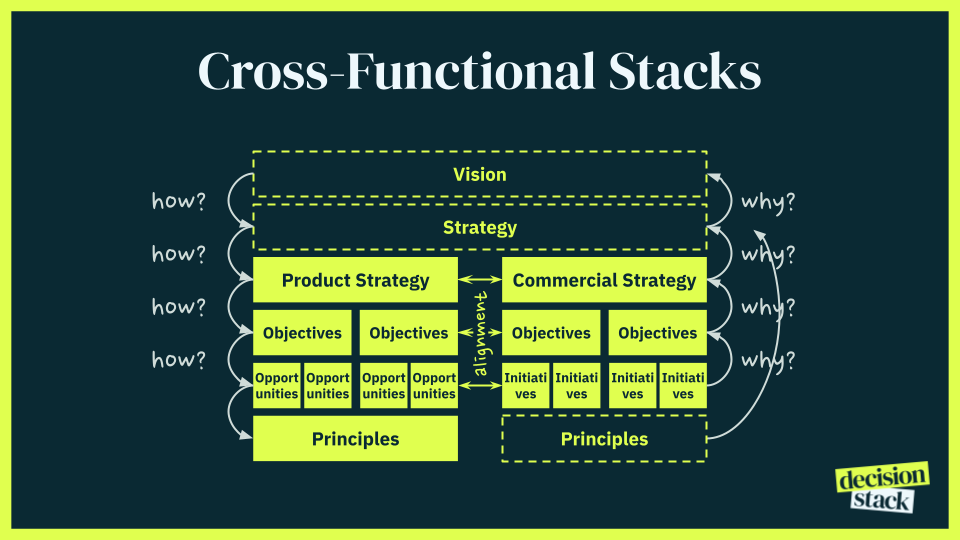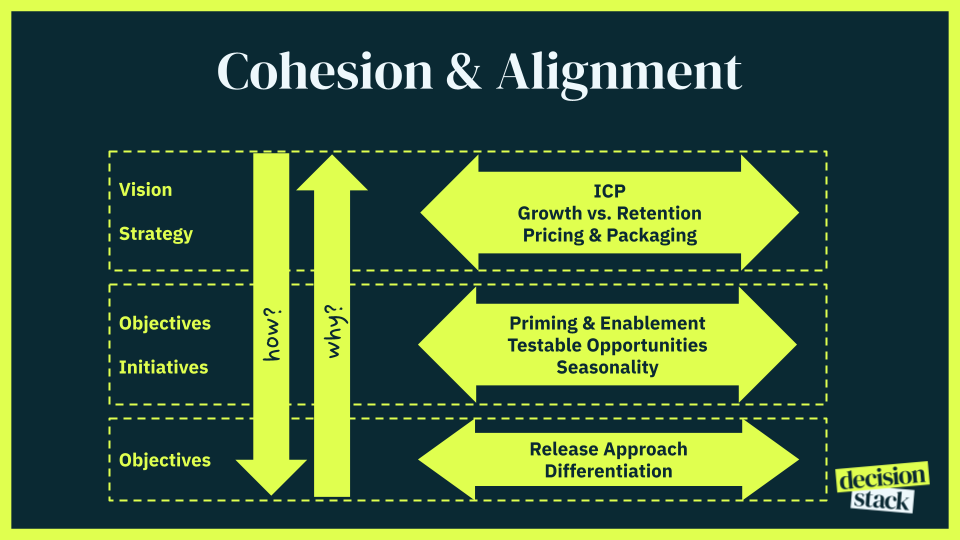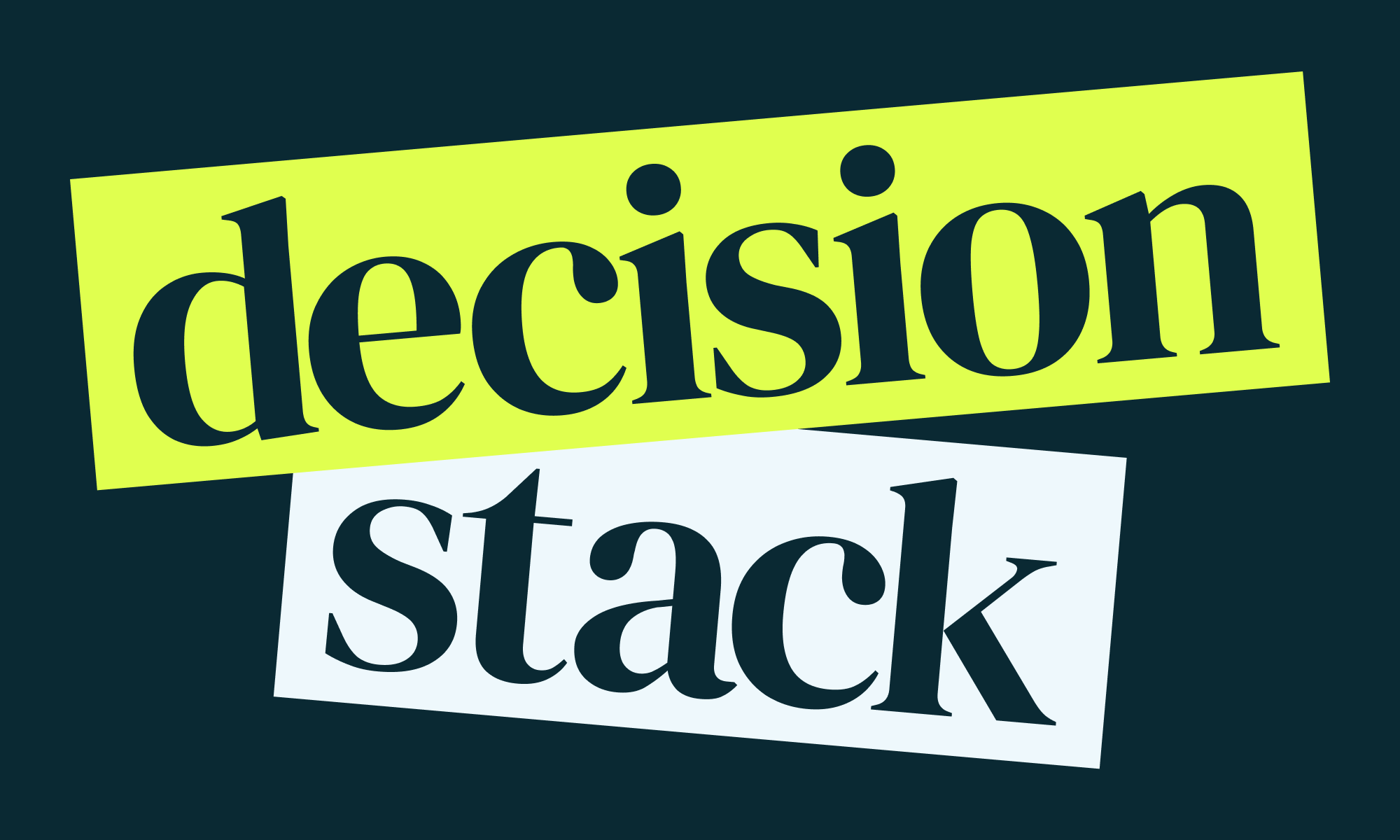Product direction meets revenue: Functional alignment for winning together
Product success is a team sport - here's how to connect your product direction to the activities of your commercial teams & to the big picture of your organisation.

The product direction we provide as product leaders doesn’t exist in a vacuum—it is only a means to an end. While it is important to focus your product and development efforts, it is only helping the business if you find, convince, and retain paying users or customers. But how do you connect your product direction to the activities of your commercial teams and to the big picture of your organisation?
Product Direction became more coherent thanks to the Decision Stack
Ever since I started working in product 15 years ago, we’ve discussed product vision and strategy. Over time, we also increasingly discussed OKRs and product principles, all of which are important elements of product direction. However, I have found that even if organisations put in the work and had all of these individual elements of product direction, they were often disconnected, sometimes even contradicting each other.
This is where Martin Eriksson’s mental model of the Decision Stack entered the scene in 2019 as a simple yet very effective way of showing how the individual elements of product direction can be connected to create a coherent narrative that aligns with your organisation's strategy and vision. It’s been great to see how it’s getting more and more traction - I think that in the past 2 years at every product conference or meetup I attended someone referenced the Decision Stack in some form. And early adopters and fans like myself are now eagerly looking forward to Martin’s book about it.
A coherent product direction is a major step forward, but no reason to lean back
Getting your product direction to tell a coherent story is a major achievement for any product leader and their team. it’s challenging to get there, and even when you have it the work is not done but you have to constantly review and keep it coherent as you move forward, learn new things, and face changes in context.
Just having a coherent product direction has very limited value. What matters is that your teams know how to apply it and that you, as an organisation, significantly increase decision velocity with the help of your product direction. This refers to both the day-to-day decisions of teams guided by Product Principles and the big and tricky questions of what to say no to in order to focus on what matters.
As if that wasn’t challenging enough, when we create, apply, and maintain our product direction it’s important that we don’t make it a siloed “product-only” exercise. Because product success is a team sport. Not only as part of our cross-functional development teams but also in how product and commercial teams play together:
Product Development and commercial activities need to connect to win together
To succeed as an organisation you need to look beyond your pure product perspective and make sure that whatever you do in product connects well with your commercial and go-to-market (GTM) activities. Because the success of your organisation not only depends on having a great product, but also on finding, attracting, retaining, and expanding the right kind of users and customers.
And to do that it’s important to consider how your product direction connects with your commercial activities:
- Is it enough to rely on your company strategy to create a connecting umbrella for product direction and GTM?
- Are there certain elements in your product direction that can and should cross-reference to your commercial direction?
- Or does your product direction even need to fully incorporate the GTM strategy, objectives, and activities?
As always in product management it depends, but among these three alternatives I lean to the middle path of looking for helpful connectors. Just relying on the company strategy will leave too much ambiguity. On the other end expecting the product direction to fully cover all of the GTM details will be overly challenging to create and maintain while also diluting the messaging for all affected audiences.
So, the “it depends” is more in the details: When thinking about HOW to connect product direction with GTM direction, what’s best for you will depend on your organisation’s business model.
B2B SaaS: Product & GTM must be aligned
Vision & Strategy Level
- Target customers & usecases are directly influenced by the Ideal Customer Profile (ICP). They benefit from underlying research on market potentials, win/loss, etc., and working on ICPs can also be a good cross-functional activity in which commercial indicators as well as signals from user research and segmented user data are considered.
- Product Strategy can help to make prioritization conflicts between Customer Success (retaining existing customers) and Sales (potentially pursuing new ICPs) explicit and provide clarity on how to balance these in product management.
- Product Marketing Teams can help with shaping Vision Statements as part of “internal product marketing”.
- Commercial teams need to understand the strategic narrative to bring customers & prospects along the journey, enabling them to say “no, and…” to feature requests.
- Defining the right pricing & packaging approach as well as whether you want to pursue a “land and expand” tactic should be a joint effort of commercial & product leadership and will shape the priority of initiatives. Potentially it will also be reflected in product principles (see below).
- If a combination of product-led and sales-led growth motions are in place it will be important that product and commercial leadership work towards the same segmentation and funnel logic and reflect this in the product strategy as well as aligned incentives with the sales team, reflected in the sales strategy
- If the commercial GTM approach relies on ecosystem partnerships this may need to be reflected in Product Direction as well.
- True PLG connoisseurs reading this will probably have additional aspects in mind - feel free to add them in the comments!
Objectives & Initiatives Level
- Commercial teams need to consider product objectives early, even before there is a product ready to be sold, so they can start “priming the wall”, for instance by building thought leadership and raising awareness of issues your future product aims to address.
- At the same time, the fact that product releases first need to be built speaks against fully synchronizing goal setting between Product and Commercial teams. For objectives that span longer periods, this can still make sense, but on a key result level, this will lead to conflicts unless the necessary “build” part can realistically be released very early in the quarter (or whatever cadence is used).
- Feedback from commercial teams, in particular marketing, can influence which opportunities to pursue and for which it’s possible to get early market feedback. Especially when working with first cohorts of users or appealing to early adopters, close collaboration with commercial teams will be important.
- Even if we as product people remain consciously flexible about the actual solutions we pursue to address the most promising opportunities it’s fair not to forget how shifts in our plans can impact commercial & support teams who may need to prepare other materials, revise enablement, etc. John Cutler recently shared his thoughts on this.
- Initiative planning needs to acknowledge seasonality because, in many SaaS industries, Q4 is responsible for a disproportionately high share of new business & renewals. This does not mean that end-of-year sales pressure gets to overrule any work contributing to the long-term product strategy, but among the different things the product team might work on, it’s fair to look for and possibly prioritize work that can be marketed and sold well during Q3 and early Q4.
Principles Level
- Product Management Principles need to be understood by commercial teams for clarity, in particular, if they have direct implications on GTM (“Stepped rollout over big bang releases”).
- Other Product Management Principles may also directly refer to the chosen pricing & packaging approach (“Consider Value differentiation for every new feature over One Size Fits all thinking”).
- Product Principles (such as “Smart defaults over configuration”) need to be discussed with commercial teams to consider commercial implications. For instance, as long as configurability is marketed and sold as a key differentiator, a smart defaults-approach (however reasonable from a product standpoint) will only succeed with corresponding adjustments in pricing and messaging.
Here’s a simplified overview of how we need to create cohesion along the different layers of the decision stack and alignment functional alignment between product and commercial teams:

While some of these considerations will also apply to other business models there are some differences in how product direction and the work of commercial teams need to connect in those cases. Let’s look at another example:
B2C subscription: A joint understanding is crucial for smooth funnels
Since there are usually no sales and customer success teams in B2C, the counterparts of the product team will mostly be in acquisition & user marketing as well as in “business owner” roles, all with a strong emphasis on usage data & segmentation as the common denominator. A smooth funnel and user journey from acquisition through sign-up and activation to subscription is what product direction and commercial activities will focus on.
While monetization will ideally be a goal for ALL product teams and not “somebody else’s problem”, it’s still common that there are dedicated product monetization teams who are not only in charge of the upsell- & checkout funnel but also create aligned principles and patterns for how to fence and upsell between free and paid memberships across the product.To determine the right overall approach it makes sense for product and commercial leadership to collaborate closely on a strategic level: Deciding how to discriminate between different pricing tiers or between free and paid needs to consider competitive positioning and the right balance between powerful upsell triggers and driving active usage even in the fenced version, especially for products with networking or collaboration features.
When assessing different scenarios both strategically as well as on an initiative level, the combination of marketing tests and usage data from A/B-tests in the product can help to find the right recipes together and consequently avoid friction along the funnel.
With regards to comparing different solutions for an opportunity or also for sharpening the general understanding of user segments, B2C product teams are in a better position than their B2B peers when it comes to assessing different options with significant usage and experimentation data.
In this context a shared understanding of how to live a culture of experimentation, continuous testing and quick release cycles will be crucial in B2C and needs to be reflected in outcome goals, flexible initiative planning and possibly also in product principles. Despite all flexibility, larger marketing campaigns (especially if offline channels are involved) will also require enough reliability in planning and well-orchestrated cross-departmental release preparation.
Apart from ensuring successful conversion as described above, another important area where product direction and commercial approach need to collaborate and align is in more emotional aspects such as brand personality, tone of voice or the question of whether and how to take a differentiating approach to UX. Here the group of potential commercial collaborators will also include brand marketing and broader market research on shifts in consumer sentiments.
What’s crucial about the overall direction along the Decision Stack is that an iterative approach is taken to validate theoretical potentials on a vision and strategy level through initial experiments on an initiative level and reflecting these learnings to refine the strategy.
Conclusion
Our examples from B2B SaaS and B2C subscription products show how product direction and commercial activities need to play together and how the different areas of expertise can fruitfully inform each other. For other business models such as E-Commerce the mix and the emphasis will be different again, but the underlying message remains the same:
As product people the Decision Stack is a great mental model to increase cohesion of our product direction. At the same time, we can’t look at product direction in isolation and must also create alignment with the rest of the organisation, especially the commercial teams.
Remember: Product success is a team sport and we can only win together!

